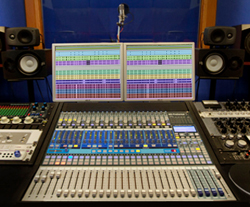
2) Individual Drums: Parallel Compression
Another common place for parallel compression is on individual drums.
Here you can actually use parallel compression in different ways. You can squash the parallel signal and really boost the sustain.
But you can also set the compressor to exaggerate the attack. I demonstrate this in the video tutorial at the bottom of this post.
3) Vocals: Parallel EQ & Compression
This technique is really cool. Let’s say you’ve created a frequency pocket where your vocals can really live clearly. If your mix is dense, simple EQ might not be enough to get the vocal to really stand out without making the vocal sound strange. A common technique here is to create a parallel vocal signal, and EQ it so that primary frequency range is focused on.
It might be a presence thing, 2 kHz to 4 kHz. It might be a treble thing. It might be that tricky “body” range around 400-600 Hz. Whatever it is, you contour your EQ to really exaggerate that zone and then compress the EQ’d signal.
How you compress it would also depend on context. Maybe you want to preserve a “round full” tone — so a softer knee/gentler compression might be the way to go. Ultimately you make a context decision.
But no need to be easy on the effect! Since it’s parallel, you can blend it back in however much you want.
The end result of the EQ -> Compression chain is that the selected frequency area stays more consistent in the vocal, which gives the vocal more presence in that pocket you created.
4) Bass And 808s: Parallel Distortion
Low frequency elements often need higher frequency content in order to stay present in a mix. Or just to stay present on small speakers. A little distortion often works very nicely. A lot of distortion blended in parallel can be a more creative option.
Try this: On a parallel track, grab your bass guitar, or 808, and run it through a distortion plugin until it sounds like someone lit the damn thing on fire. Then throw on a low pass filter and cut away all of the harsh harmonics – might be as low as 400 Hz or lower.
Then, with the whole song playing, blend the parallel signal back in with the dry. Listen for the presence of the bass/808 to suddenly become much thicker and apparent. Find that sweet spot and rock out. Often times I’ll err on the heavier side with this as I usually dig the character it adds.
Matthew Weiss engineers from his private facility in Philadelphia, PA. A list of clients and credits are available at Weiss-Sound.com. He’s also the author of the Mixing Rap Vocals tutorials, available here.
Be sure to visit The Pro Audio Files for more great recording content. To comment or ask questions about this article, go here.
